As an Amazon Associate we earn from qualifying purchases.
Pool can be hard to play the first time. Many beginners like to get creative and try to create a difficult shot yet they tend to forget to start at the basic fundamentals. In order to get better at pool, you need to understand the basics. Here’s how to get better at pool.
How to Get Better at Pool
Remember: even the best professional pool players also started at the very basics. That’s why you should first practice the fundamentals of pool if you want to get better at it.
When you’re just getting started, you probably have a basic pool cue and hardly any practice under your belt. As you progress with the fundamentals you will learn some of the more advanced parts of pool, like combo shots, draw shots, and cue ball spin techniques.
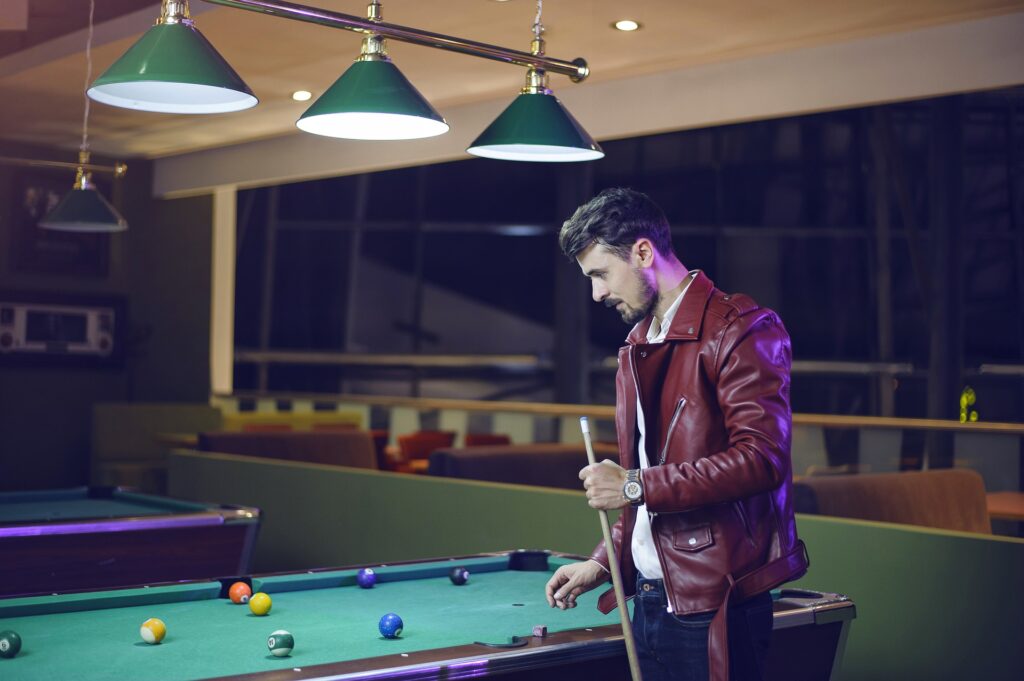
Practice Fundamental Skills
Getting used to the grip, working on your swing, and knowing (as much as practicing) your bridges it’s a great way to get a solid foundation to improve your pool game.
Get Used to Your Grip
A common misconception of most beginner pool players make is thinking that gripping tightly provides better accuracy. Of course, it’s natural to think that the harder you grip your cue, the more control you will have over it.
However, it doesn’t work that way in pool. Holding your pool cue light and with a loose grip makes for a better shot. Holding the cue too tightly causes the butt of the cue to rise when you shoot.
This takes the end of the stick above horizontal on the backswing. It makes it harder to shoot a straight and accurate shot. If you also grip the cue tightly, it increases the chances of accidentally jumping the cue ball off the table.
How to Grip the Cue Stick
Your grip should be just enough so the cue won’t pick off the table. The pool cue should be held lightly and resting on your fingers.
You shouldn’t make contact with the cue with your palm. Try to keep the grip light while also maintaining control.
The best grip is a balance between lightness and control, which you’ll find true for other sports as well. For example, when holding the paddle in pickleball or the racket in tennis, having your grip follow this is also best practice..
Work On Your Pendulum Swing
You need to shoot with your body in alignment with your aiming sight. Shooting still can be very hard if you have shaky arms.
Most who start with playing pool for the first time use too much movement in their upper arm when shooting. To resolve this, you should think of your shooting arm as a pendulum.
- Your upper arm should be consistent and still throughout the shooting process. Your lower arm makes all the movement with a swinging motion back and forth.
- Your backswing should be slow and steady for better consistency. Your shooting hand should always be directly under your elbow when you are holding the cue.
- You can have your lower arm swing past the elbow when you make an impact with the cue ball. However, it should not stop short of your elbow.
You can start practicing your pendulum swing with a variety of long shots. The backswing should be consistently slow but you can control the speed of your shot with the forward swing.
Practice Your Bridges
Making your bridge is one of the most important basic fundamentals you need to master.
If your bridge is faulty, it will affect your grip, stance, and alignment even though you fully mastered them.
Most people use two types of bridges; the close and open bridge. They both have their strengths and we will explain why you should choose one over the other.
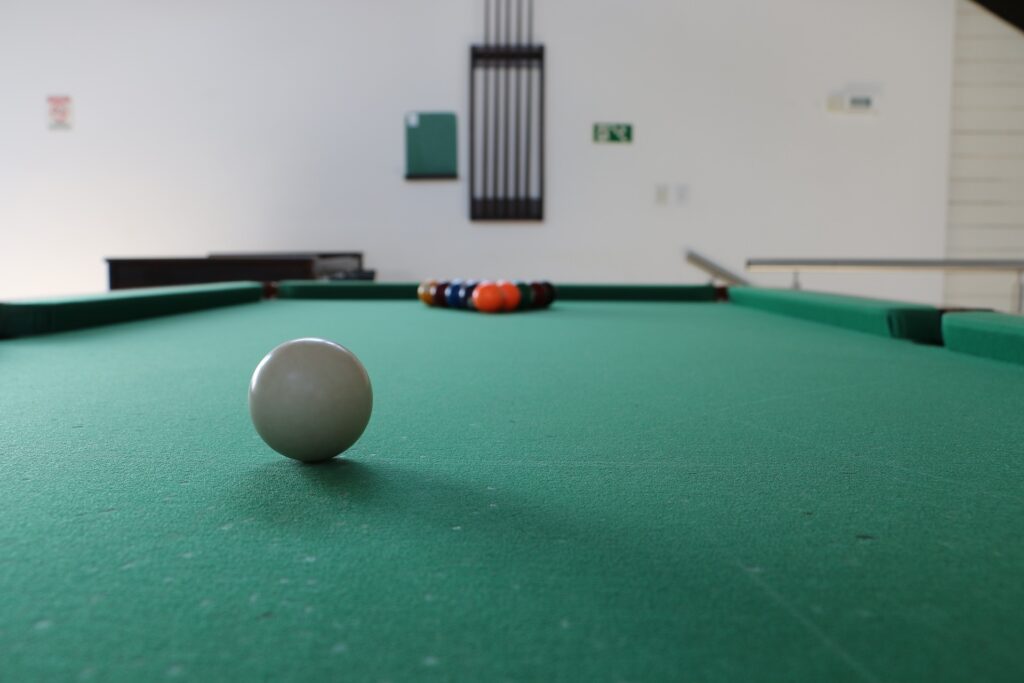
Types of Bridges
- Open bridge: open bridge is great for starting players and suited for softer shots.
- Closed bridge: most experienced players prefer making a closed bridge because it lets them shoot harder shots and gives more spin on the cue ball.
- Rail bridge: an essential part of your bridge arsenal that lets you shoot for the balls that are close to the rail.
- Over the ball bridge: also an essential part of your bridge techniques for when you need to shoot over an obstructing ball.
How to Improve your Aiming at Pool
Now that you’ve mastered the basic fundamentals, it’s time to improve your aiming. Aiming the ball should be easy now that you have the foundations of the fundamentals.
Work On Your Stance
While technically a fundamental in pool, working on your stance helps a lot with your aiming. A general rule for pool stance is to have your front foot at least a shoulder-width apart from your rear foot.
- You can place your rear foot at an angle of about 45°. Make sure you feel stable and comfortable and your front foot should point straight forward.
- Make sure your weight is equally distributed to both your feet.
- When you lean forward, keep your head low and it should be at the same level as your cue stick. You shouldn’t feel strained in this position and find it comfortable.
- Place a bit of your weight on the bridge hand. Think of it as a tripod stance with your two feet and the bridge hand.
- Maintain this position and make sure it feels comfortable, balanced, and low. Now it’s up to you to consistently maintain this position every time you take a shot.
Take note that people have different stances because they have different bodies. Your stance should be a combination of comfort, consistency, and accurate aiming. If you hit those three with your stance then you shouldn’t change it.
You also have to look into the factors that will affect how you make your stance such as;
- Height
- Body type
- Playing style
- Dominant hand (left or right)
- Flexibility
- Injuries or conditions
Concentrate on Your Target
Before making a shot, you should know what target pocket you are hitting the ball into. This means visioning the angle, bank, or combo shot you have to make. You also have to imagine where you should hit your cue ball and where your cue ball hits the object ball.
Have you ever played a computer pool game? They sometimes use lines to indicate where your balls are going to travel. This line is what you have to imagine during a pool game to help you with aiming.
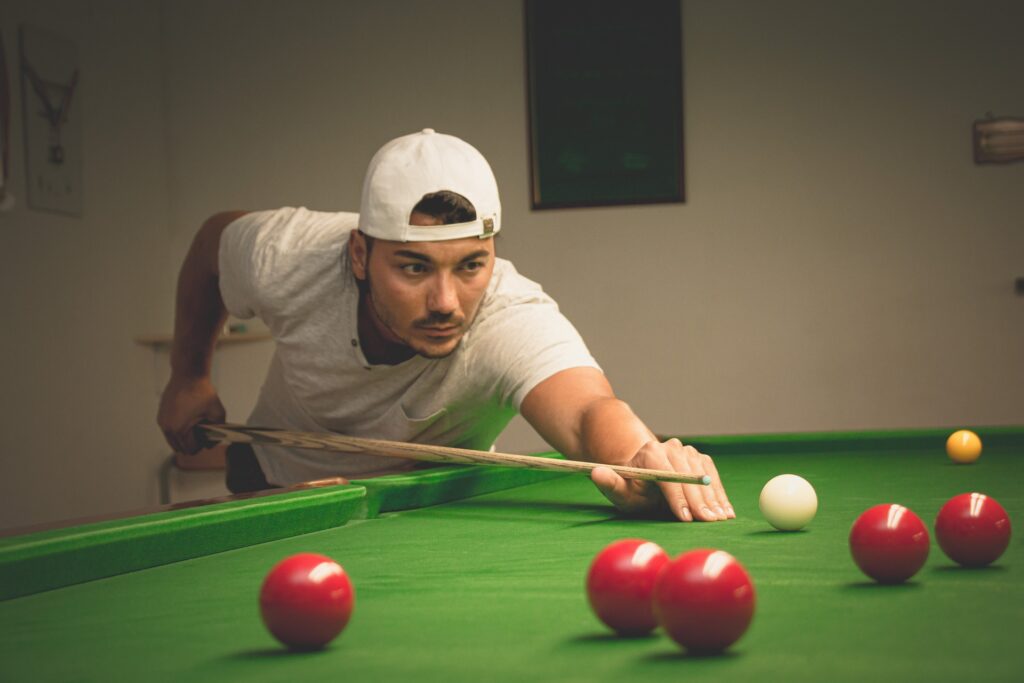
- Follow the line back and forth at least two times.
- Your eyes should end to where you want to hit your cue ball.
- Now focus on that area of the cue ball where you want to hit your cue stick and make your stance.
- Align your cue stick to where you want the cue ball to hit the object ball and make the shot.
Do this for every shot you take and be consistent. It will soon become a natural part of your pre-shot routine and you’ll notice an increase in your shot accuracy.
Identify How You Get Into a Rhythm
A lot of professional players do a pre-shot routine and pre-stroke routine to get their body into a rhythm. A pre-shot routine is how you pace yourself between shots in a pool game.
Pre-Shot Routine
Most players like to take a quick survey of the whole table and walking around the pool table for different angles.
After surveying some people like to chalk the cue tip and eye the target pocket with focus. In some countries, they add the powder to their hands to give them a better grip.
Add this to picturing your imaginary line and you have a pre-shot routine to help you get into concentration mode.
Pre-Stroke Routine
You can also add a pre-stroke routine to make you more comfortable in taking shots. A lot of pool players like to do warm-up strokes.
The warm-up strokes should be slow on both the back and forward swings. On your last warm-up stroke, stop right before the cue ball target to check if your alignment is correct.
This is how most experienced pool players do their pre-stroke routine to let them hit the cue ball more accurately.
Practice Your Stroke
The stroke to hit the cue ball matters most for hitting a shot. No matter what preparations you do, if you make a mistake in your stroke, you’ll end up with a completely different shot outcome.
You should always maintain a slow and steady backswing. Most experienced pool players agree that a slow backswing leads to better shot accuracy.
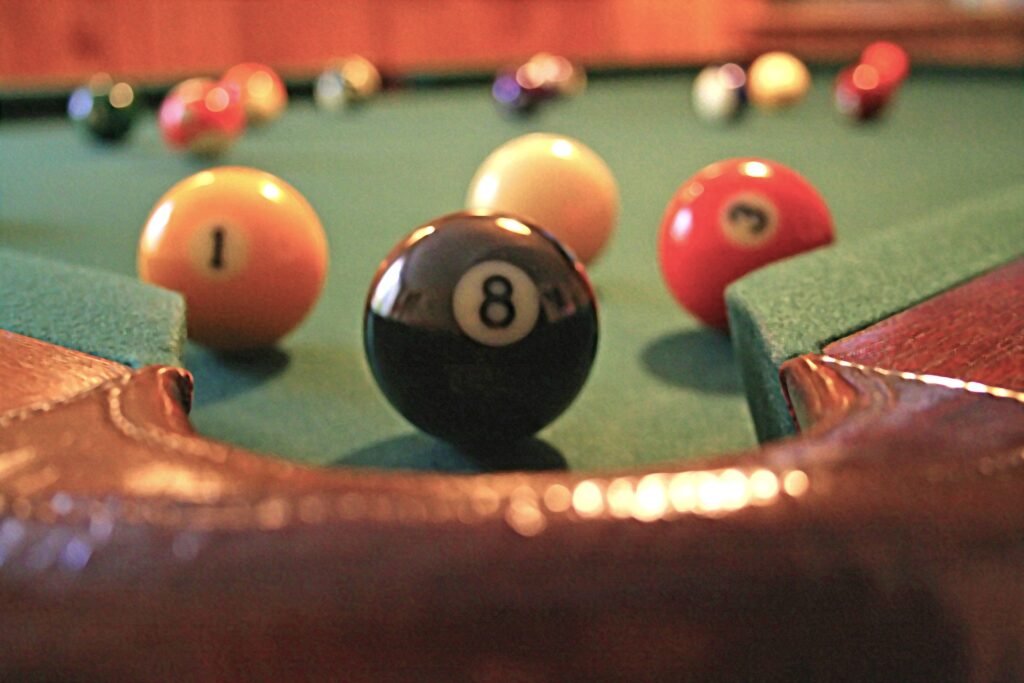
- Keep your elbow up and in line with your body, head, and bridge when you make the backswing.
- Your cue stick and arms should never move from side to side or up and down. Make sure that to remember the pendulum swing (upper arm fixed while the lower arm swings).
- Acceleration should only happen when you make the forward swing. The speed of your forward swing depends on how hard you want the cue ball to travel.
- Make sure your body stays consistently still.
- Keep your head still through the shot and remember to follow through.
Maintain Position and Follow Through
Most starting pool players stand up from the pool table as soon as they make a shot. You should correct this. You want to stay in position after the shot mostly for the follow-through.
- Follow Through: follow-through keeps your shots consistent and ensures your shots are accurate. Your follow-through should be almost in contact with the table as you near the forward swing motion.
- Observe the Shot: staying in your position after taking the shot allows you to look closely at the movement of your cue ball. This will allow you to analyze and tweak your shot for better accuracy.
Work on Your Weak Arm
Believe it or not, you would wish that you can shoot with your weak arm because of some scenarios in pool. If you can learn to shoot with both your arms, you get a lot of advantages in pool. Some shots are too difficult or uncomfortable for you to do with your dominant hand.
If you regularly practice your weak arm, you will eventually get used to it and can easily shoot with your non-dominant arm. It’s better if you have a pool table at home so you can practice all you want without looking awkward to other people.
You can also train your non-dominant hand by using it in your daily life. For example, basic things such as holding a cup with your non-dominant hand to drink will help strengthen it.
Work on Your Break Shot
A break can sometimes get you the win. A solid break will position the object balls cleanly so you can sequence your shots with ease and get the win.
Popular pool players like Django Bustamante are famous for their break shot and for good reason. It gives you the opportunity and huge advantage of shooting again.
If you’re good enough, you can break the rack and shoot again without letting your opponent shoot and win the set.
How to Get a Great Break
- Tweak Your Power: It’s not all about power. In fact, if you put too much power, you might end up scratching the cue ball or end up in a bad position. First, try with a lighter break and get a feel for it before upping the power.
- Memorize the Balls: If you watch your breaks all the time, you will eventually notice a pattern every time you take consistent breaks. This will help you predict where object balls will be when you break.
- Control the Cue Ball: most professional pool players like to control their cue ball by putting a bit of backspin to it. You can do this by hitting the cue ball just below the center.
Additional Tips
If you’re not working on your fundamentals and aiming because you can’t go play at the pool table just yet, there are things that you can do to help you get better at pool.
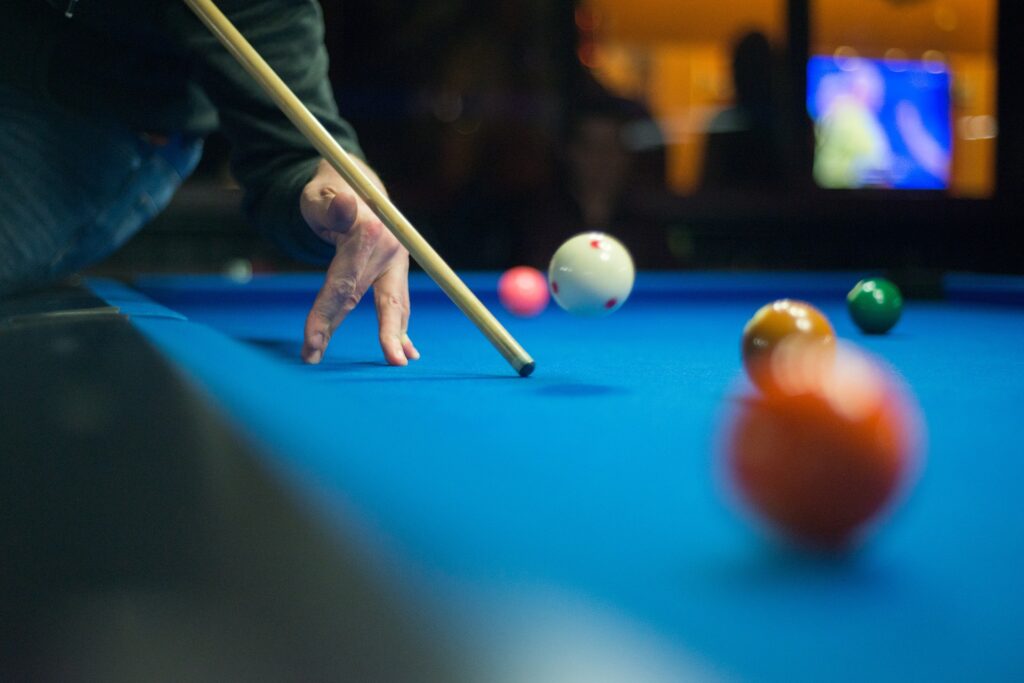
Identify Your Weakness
The best way to identify your weakness is to play against someone preferably better than you. Pay attention to shots that you miss and how your opponent takes a shot.
There might be shots that you think you’re not comfortable taking and that’s how you identify your weakness.
Once you identify your weakness, work on them by practicing shots that are similar to your weakness. Practice it until it becomes easy for you to take.
Play Against Pool Players Better Than You
Some of the great pool players played with other great pool players and learned a thing or two. You should play with pool players better than you. For one, you can watch how they approach the pool table and their technique.
You also get forced to do better and harness the best of your abilities. After the game, you can talk with them afterward and learn some tips that will also help you get better.
Watch Professional Matches
Watching professional pool players play is a spectacle to marvel at. You get to learn a lot about how they carry themselves on the pool table and how they make their shots.
You can search Youtube for match clips of professional pool players. A good place to start would be watching Earl Strickland, Efren Reyes, and Mike Sigel. They’re some of the best pool players of all time.
Watch every ball placement, stance, grip, power, and cue ball control that will help you develop your own pool skills.
Practice Your Bank Shots
If you really want to up your game, you should also work on your bank shots. Most pool players nowadays prefer doing jump shots yet bank shots give you better ball control if you can master them.
It takes time to master bank shots and if you have a pool table at home, you should practice it a lot. You can practice bank shots a few minutes before setting up a game if you’re in the pool hall.
Bank shots also add to your style points and make an impression on the crowd.
Chalk Your Cue Properly
The amount of chalk on your cue can affect your shots. You should also know how to chalk your cue. You should make it a habit to chalk your cue before you attempt a shot.
To properly chalk your cue:
- Use a brushing motion with the chalk across the cue tip.
- Spin your cue and continue the brushing motion to evenly apply the chalk on the tip.
- Do not spin the chalk on the tip. It doesn’t apply it evenly and you end up wasting more chalk.
Conclusion
Practicing the fundamentals and your aiming will greatly improve your pool skills. In order to get better at pool, you need to spend time practicing and working at the pool table. If you keep on practicing you will eventually get better at it.